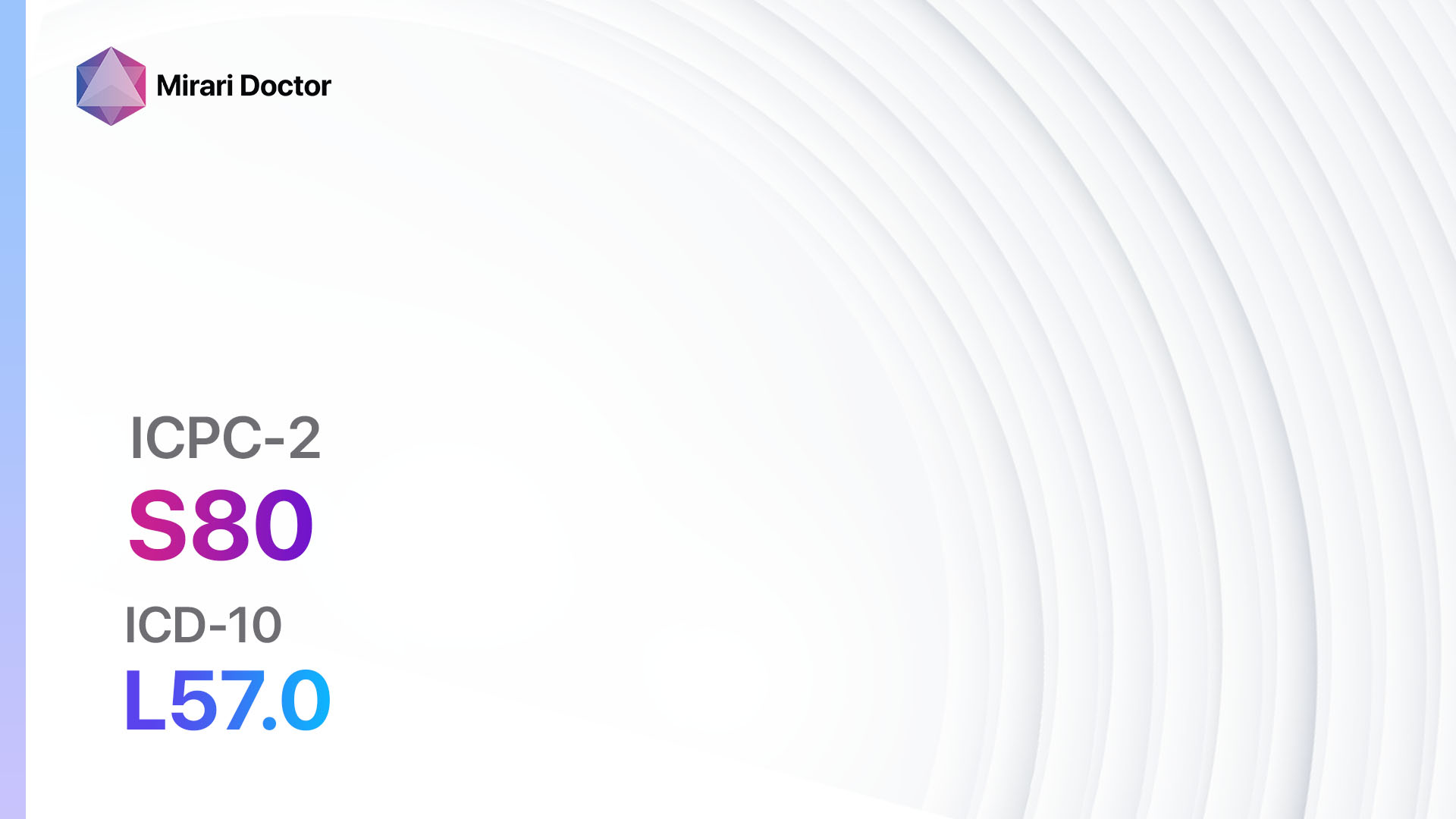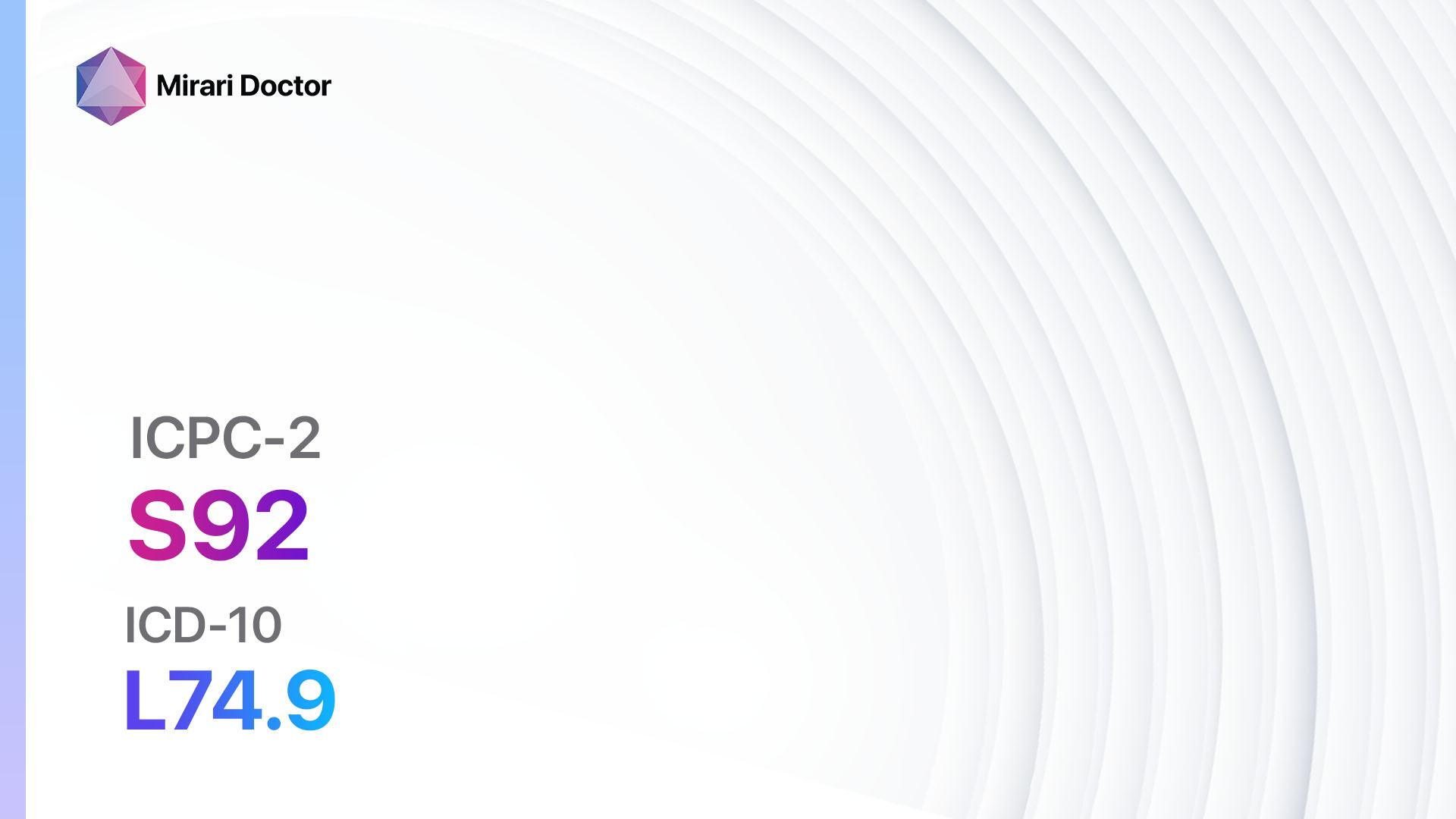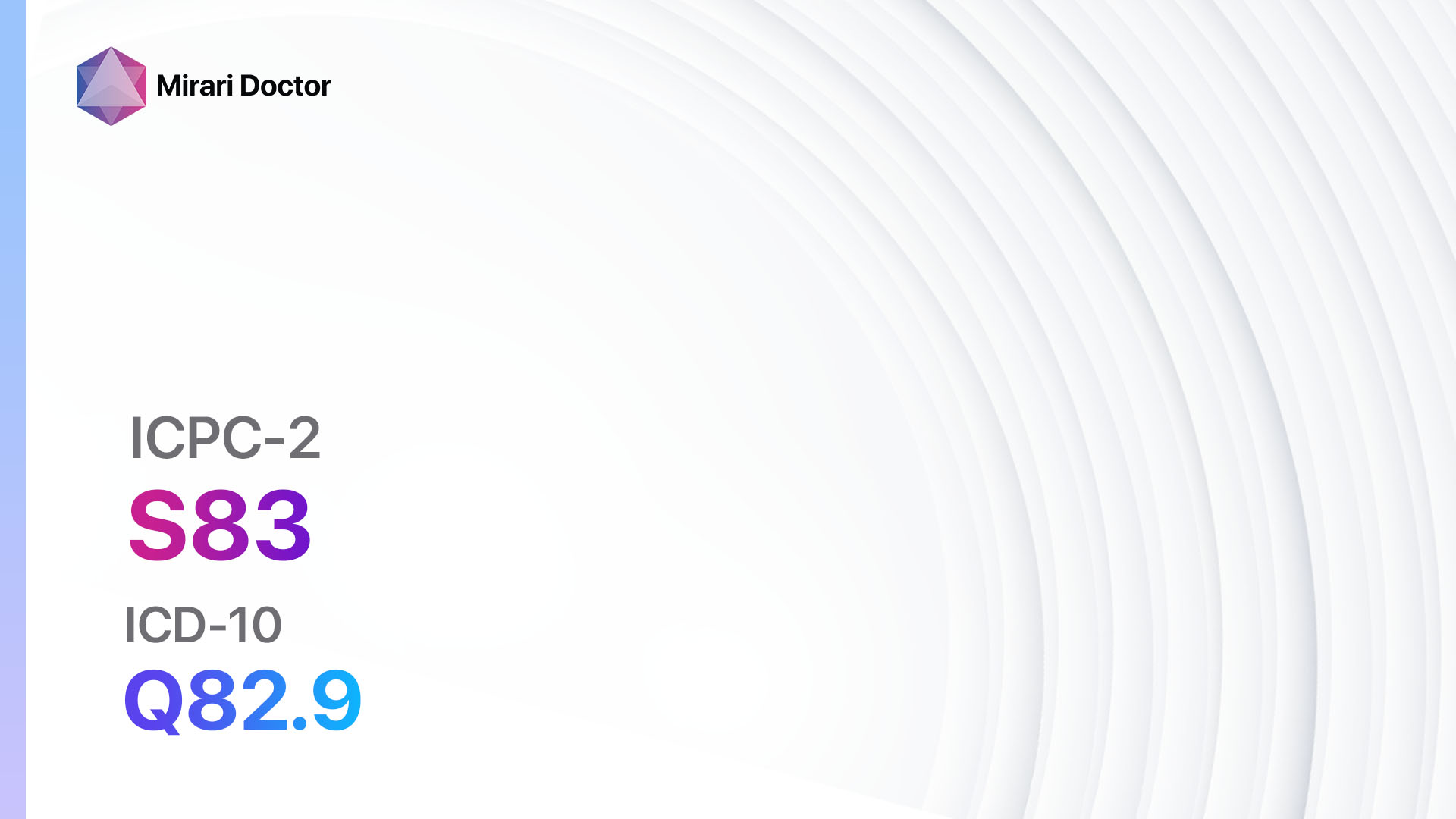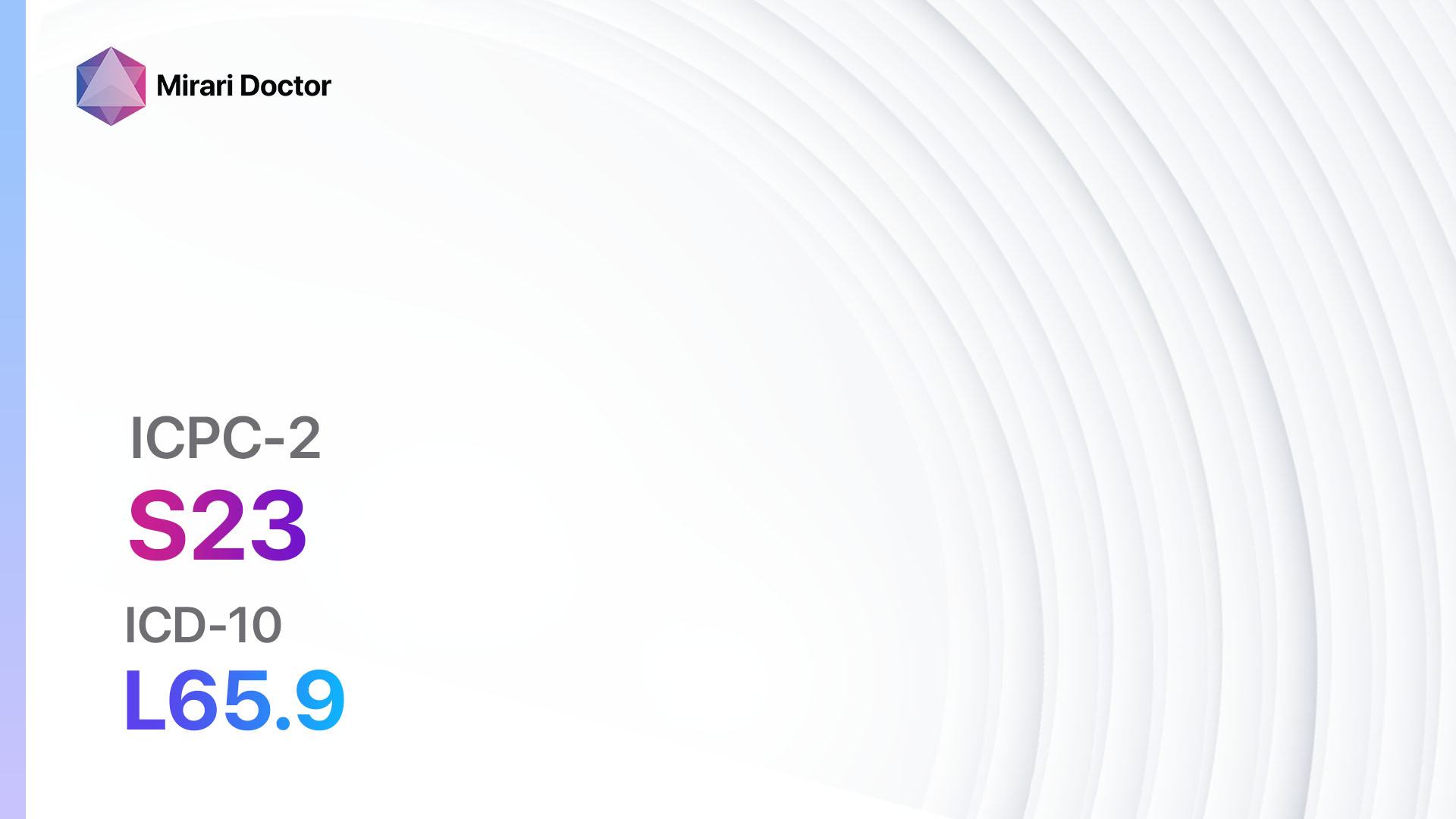
Introduction
Fear of cancer of the skin is a common concern among individuals, as skin cancer is one of the most prevalent types of cancer worldwide[1]. This guide aims to provide healthcare professionals with a comprehensive approach to diagnosing and managing patients with a fear of skin cancer. By understanding the symptoms, causes, and appropriate diagnostic steps, healthcare professionals can effectively address patient concerns and provide appropriate interventions.
Codes
- ICPC-2 Code: S26 Fear of cancer of skin[2]
- ICD-10 Code: Z71.1 Person with feared complaint in whom no diagnosis is made[3]
Symptoms
- Persistent worry or fear about developing skin cancer
- Frequent checking of the skin for any changes or abnormalities
- Avoidance of sun exposure or excessive use of sun protection measures
- Anxiety or distress related to the fear of skin cancer[4]
Causes
- Personal or family history of skin cancer
- Previous experience with skin cancer or precancerous lesions
- Excessive exposure to ultraviolet (UV) radiation from the sun or tanning beds
- Presence of numerous moles or atypical moles
- History of severe sunburns
- Weakened immune system[5]
Diagnostic Steps
Medical History
- Gather information about the patient’s personal and family history of skin cancer
- Assess the patient’s exposure to UV radiation, including sun exposure and tanning bed use
- Inquire about any previous skin cancer diagnoses or precancerous lesions
- Evaluate the patient’s anxiety levels and the impact of fear on their daily life[6]
Physical Examination
- Perform a thorough examination of the patient’s skin, paying close attention to any suspicious lesions or changes
- Document the presence of moles, freckles, or other pigmented lesions
- Assess the patient’s overall skin condition, including signs of sun damage or actinic keratosis
- Evaluate the patient’s lymph nodes for any enlargement or tenderness[7]
Determine Severity
- Classify the fear of skin cancer based on severity and impact on the patient’s daily life
- Mild: Occasional worry or fear, minimal impact on daily activities
- Moderate: Frequent worry or fear, moderate impact on daily activities
- Severe: Constant worry or fear, significant impairment of daily activities[8]
Laboratory Tests
- No specific laboratory tests are necessary for the diagnosis of fear of skin cancer
- However, blood tests may be ordered to rule out any underlying medical conditions contributing to anxiety or fear[9].
Diagnostic Imaging
- No diagnostic imaging is necessary for the diagnosis of fear of skin cancer
Other Tests
- No other diagnostic tests are necessary for the diagnosis of fear of skin cancer
Follow-up and Patient Education
- Schedule regular follow-up appointments to monitor the patient’s anxiety levels and provide ongoing support
- Educate the patient about the importance of regular skin checks and early detection of skin cancer
- Provide information on sun protection measures and the importance of UV radiation avoidance[10]
Possible Interventions
Traditional Interventions
Medications:
Top 5 drugs for fear of skin cancer:
- Selective serotonin reuptake inhibitors (SSRIs) (e.g., Sertraline, Fluoxetine):
- Cost: Generic versions can be $3-$50/month.
- Contraindications: Hypersensitivity to SSRIs, concurrent use of monoamine oxidase inhibitors (MAOIs).
- Side effects: Nausea, headache, insomnia.
- Severe side effects: Serotonin syndrome, suicidal thoughts.
- Drug interactions: MAOIs, other serotonergic drugs.
- Warning: Close monitoring for worsening depression or emergence of suicidal thoughts.
- Benzodiazepines (e.g., Lorazepam, Alprazolam):
- Cost: Generic versions can be $3-$50/month.
- Contraindications: Acute narrow-angle glaucoma, concurrent use of opioids.
- Side effects: Drowsiness, dizziness, confusion.
- Severe side effects: Respiratory depression, dependence.
- Drug interactions: Opioids, alcohol.
- Warning: Risk of dependence and withdrawal symptoms with long-term use.
- Beta-blockers (e.g., Propranolol, Atenolol):
- Cost: Generic versions can be $3-$30/month.
- Contraindications: Severe bradycardia, heart block.
- Side effects: Fatigue, dizziness, bradycardia.
- Severe side effects: Bronchospasm, heart failure.
- Drug interactions: Calcium channel blockers, insulin.
- Warning: Should not be abruptly stopped.
- Antidepressants (e.g., Escitalopram, Venlafaxine):
- Cost: Generic versions can be $3-$50/month.
- Contraindications: Hypersensitivity to antidepressants, concurrent use of MAOIs.
- Side effects: Nausea, headache, sexual dysfunction.
- Severe side effects: Serotonin syndrome, suicidal thoughts.
- Drug interactions: MAOIs, other serotonergic drugs.
- Warning: Close monitoring for worsening depression or emergence of suicidal thoughts.
- Antipsychotics (e.g., Quetiapine, Risperidone):
- Cost: Generic versions can be $10-$100/month.
- Contraindications: Hypersensitivity to antipsychotics, dementia-related psychosis.
- Side effects: Sedation, weight gain, extrapyramidal symptoms.
- Severe side effects: Neuroleptic malignant syndrome, tardive dyskinesia.
- Drug interactions: Other antipsychotics, antihypertensives.
- Warning: Increased risk of mortality in elderly patients with dementia-related psychosis.
Alternative Drugs:
- Cognitive-behavioral therapy (CBT): A non-pharmacological intervention that focuses on identifying and changing negative thought patterns and behaviors associated with fear of skin cancer. Cost: Varies depending on the therapist and location.
- Mindfulness-based stress reduction (MBSR): A technique that combines mindfulness meditation, body awareness, and yoga to reduce stress and anxiety. Cost: Varies depending on the program and location.
- Support groups: Joining a support group for individuals with a fear of skin cancer can provide emotional support and a sense of community. Cost: Varies depending on the organization or group.
Lifestyle Interventions
- Encourage the patient to practice sun protection measures, such as wearing sunscreen, protective clothing, and hats
- Educate the patient about the importance of regular skin self-examinations and seeking medical attention for any concerning skin changes
- Recommend stress management techniques, such as exercise, meditation, or yoga, to help reduce anxiety levels
- Suggest seeking support from friends, family, or mental health professionals to address and manage fear and anxiety
Mirari Cold Plasma Alternative Intervention
Understanding Mirari Cold Plasma
- Safe and Non-Invasive Treatment: Mirari Cold Plasma is a safe and non-invasive treatment option for various skin conditions. It does not require incisions, minimizing the risk of scarring, bleeding, or tissue damage.
- Efficient Extraction of Foreign Bodies: Mirari Cold Plasma facilitates the removal of foreign bodies from the skin by degrading and dissociating organic matter, allowing easier access and extraction.
- Pain Reduction and Comfort: Mirari Cold Plasma has a local analgesic effect, providing pain relief during the treatment, making it more comfortable for the patient.
- Reduced Risk of Infection: Mirari Cold Plasma has antimicrobial properties, effectively killing bacteria and reducing the risk of infection.
- Accelerated Healing and Minimal Scarring: Mirari Cold Plasma stimulates wound healing and tissue regeneration, reducing healing time and minimizing the formation of scars.
Mirari Cold Plasma Prescription
Video instructions for using Mirari Cold Plasma Device – S26 Fear of cancer of skin (ICD-10:Z71.1)
| Mild | Moderate | Severe |
| Mode setting: 1 (Infection) Location: 0 (Localized) Morning: 15 minutes, Evening: 15 minutes |
Mode setting: 1 (Infection) Location: 0 (Localized) Morning: 30 minutes, Lunch: 30 minutes, Evening: 30 minutes |
Mode setting: 1 (Infection) Location: 0 (Localized) Morning: 30 minutes, Lunch: 30 minutes, Evening: 30 minutes |
| Mode setting: 2 (Wound Healing) Location: 0 (Localized) Morning: 15 minutes, Evening: 15 minutes |
Mode setting: 2 (Wound Healing) Location: 0 (Localized) Morning: 30 minutes, Lunch: 30 minutes, Evening: 30 minutes |
Mode setting: 2 (Wound Healing) Location: 0 (Localized) Morning: 30 minutes, Lunch: 30 minutes, Evening: 30 minutes |
| Total Morning: 30 minutes approx. $5 USD, Evening: 30 minutes approx. $5 USD |
Total Morning: 60 minutes approx. $10 USD, Lunch: 60 minutes approx. $10 USD, Evening: 60 minutes approx. $10 USD, |
Total Morning: 60 minutes approx. $10 USD, Lunch: 60 minutes approx. $10 USD, Evening: 60 minutes approx. $10 USD, |
| Usual treatment for 7-60 days approx. $70 USD – $600 USD | Usual treatment for 6-8 weeks approx. $1,260 USD – $1,680 USD |
Usual treatment for 3-6 months approx. $2,700 USD – $5,400 USD
|
 |
|
Use the Mirari Cold Plasma device to treat Fear of cancer of skin effectively.
WARNING: MIRARI COLD PLASMA IS DESIGNED FOR THE HUMAN BODY WITHOUT ANY ARTIFICIAL OR THIRD PARTY PRODUCTS. USE OF OTHER PRODUCTS IN COMBINATION WITH MIRARI COLD PLASMA MAY CAUSE UNPREDICTABLE EFFECTS, HARM OR INJURY. PLEASE CONSULT A MEDICAL PROFESSIONAL BEFORE COMBINING ANY OTHER PRODUCTS WITH USE OF MIRARI.
Step 1: Cleanse the Skin
- Start by cleaning the affected area of the skin with a gentle cleanser or mild soap and water. Gently pat the area dry with a clean towel.
Step 2: Prepare the Mirari Cold Plasma device
- Ensure that the Mirari Cold Plasma device is fully charged or has fresh batteries as per the manufacturer’s instructions. Make sure the device is clean and in good working condition.
- Switch on the Mirari device using the power button or by following the specific instructions provided with the device.
- Some Mirari devices may have adjustable settings for intensity or treatment duration. Follow the manufacturer’s instructions to select the appropriate settings based on your needs and the recommended guidelines.
Step 3: Apply the Device
- Place the Mirari device in direct contact with the affected area of the skin. Gently glide or hold the device over the skin surface, ensuring even coverage of the area experiencing.
- Slowly move the Mirari device in a circular motion or follow a specific pattern as indicated in the user manual. This helps ensure thorough treatment coverage.
Step 4: Monitor and Assess:
- Keep track of your progress and evaluate the effectiveness of the Mirari device in managing your Fear of cancer of skin. If you have any concerns or notice any adverse reactions, consult with your health care professional.
Note
This guide is for informational purposes only and should not replace the advice of a medical professional. Always consult with your healthcare provider or a qualified medical professional for personal advice, diagnosis, or treatment. Do not solely rely on the information presented here for decisions about your health. Use of this information is at your own risk. The authors of this guide, nor any associated entities or platforms, are not responsible for any potential adverse effects or outcomes based on the content.
Mirari Cold Plasma System Disclaimer
- Purpose: The Mirari Cold Plasma System is a Class 2 medical device designed for use by trained healthcare professionals. It is registered for use in Thailand and Vietnam. It is not intended for use outside of these locations.
- Informational Use: The content and information provided with the device are for educational and informational purposes only. They are not a substitute for professional medical advice or care.
- Variable Outcomes: While the device is approved for specific uses, individual outcomes can differ. We do not assert or guarantee specific medical outcomes.
- Consultation: Prior to utilizing the device or making decisions based on its content, it is essential to consult with a Certified Mirari Tele-Therapist and your medical healthcare provider regarding specific protocols.
- Liability: By using this device, users are acknowledging and accepting all potential risks. Neither the manufacturer nor the distributor will be held accountable for any adverse reactions, injuries, or damages stemming from its use.
- Geographical Availability: This device has received approval for designated purposes by the Thai and Vietnam FDA. As of now, outside of Thailand and Vietnam, the Mirari Cold Plasma System is not available for purchase or use.
References
- American Cancer Society. (2023). Key Statistics for Skin Cancer. Retrieved from https://www.cancer.org/cancer/skin-cancer/about/key-statistics.html
- World Organization of Family Doctors. (2020). ICPC-2 English. Retrieved from https://www.globalfamilydoctor.com/site/DefaultSite/filesystem/documents/Groups/WICC/International%20Classification%20of%20Primary%20Care%20Dec16.pdf
- World Health Organization. (2019). ICD-10 Version:2019. Retrieved from https://icd.who.int/browse10/2019/en#/Z71.1
- Beutel, M. E., Fischbeck, S., Binder, H., et al. (2015). Depression, anxiety and quality of life in long-term survivors of malignant melanoma: A register-based cohort study. PLoS One, 10(1), e0116440.
- Skin Cancer Foundation. (2023). Skin Cancer Causes and Risk Factors. Retrieved from https://www.skincancer.org/risk-factors/
- Oliveria, S. A., Shuk, E., Hay, J. L., et al. (2013). Melanoma survivors: health behaviors, surveillance, psychosocial factors, and family concerns. Psycho-Oncology, 22(1), 106-116.
- American Academy of Dermatology Association. (2023). How to perform a skin self-exam. Retrieved from https://www.aad.org/public/diseases/skin-cancer/find/at-home/skin-self-exam
- Körner, A., Coroiu, A., Martins, C., & Wang, B. (2013). Predictors of skin self-examination before and after a melanoma diagnosis: The role of medical advice and patient’s level of education. International Archives of Medicine, 6(1), 8.
- Tripp, M. K., Watson, M., Balk, S. J., et al. (2016). State of the science on prevention and screening to reduce melanoma incidence and mortality: The time is now. CA: A Cancer Journal for Clinicians, 66(6), 460-480.
- US Preventive Services Task Force. (2016). Screening for Skin Cancer: US Preventive Services Task Force Recommendation Statement. JAMA, 316(4), 429-435.
Related articles
Made in USA



























